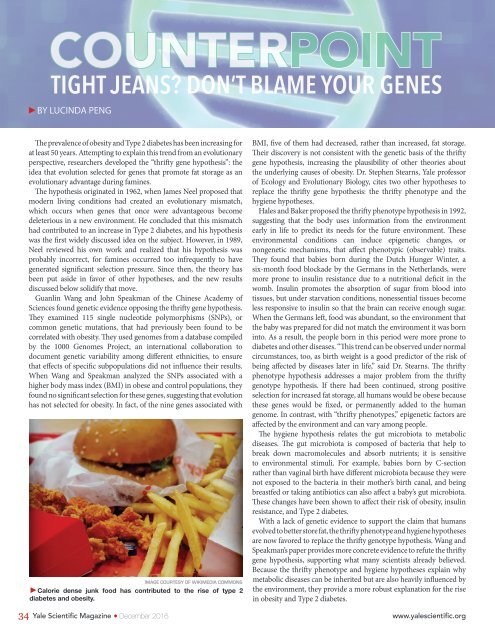YSM Issue 90.1
You also want an ePaper? Increase the reach of your titles
YUMPU automatically turns print PDFs into web optimized ePapers that Google loves.
COUNTERPOINT<br />
TIGHT JEANS? DON’T BLAME YOUR GENES<br />
►BY LUCINDA PENG<br />
The prevalence of obesity and Type 2 diabetes has been increasing for<br />
at least 50 years. Attempting to explain this trend from an evolutionary<br />
perspective, researchers developed the “thrifty gene hypothesis”: the<br />
idea that evolution selected for genes that promote fat storage as an<br />
evolutionary advantage during famines.<br />
The hypothesis originated in 1962, when James Neel proposed that<br />
modern living conditions had created an evolutionary mismatch,<br />
which occurs when genes that once were advantageous become<br />
deleterious in a new environment. He concluded that this mismatch<br />
had contributed to an increase in Type 2 diabetes, and his hypothesis<br />
was the first widely discussed idea on the subject. However, in 1989,<br />
Neel reviewed his own work and realized that his hypothesis was<br />
probably incorrect, for famines occurred too infrequently to have<br />
generated significant selection pressure. Since then, the theory has<br />
been put aside in favor of other hypotheses, and the new results<br />
discussed below solidify that move.<br />
Guanlin Wang and John Speakman of the Chinese Academy of<br />
Sciences found genetic evidence opposing the thrifty gene hypothesis.<br />
They examined 115 single nucleotide polymorphisms (SNPs), or<br />
common genetic mutations, that had previously been found to be<br />
correlated with obesity. They used genomes from a database compiled<br />
by the 1000 Genomes Project, an international collaboration to<br />
document genetic variability among different ethnicities, to ensure<br />
that effects of specific subpopulations did not influence their results.<br />
When Wang and Speakman analyzed the SNPs associated with a<br />
higher body mass index (BMI) in obese and control populations, they<br />
found no significant selection for these genes, suggesting that evolution<br />
has not selected for obesity. In fact, of the nine genes associated with<br />
IMAGE COURTESY OF WIKIMEDIA COMMONS<br />
►Calorie dense junk food has contributed to the rise of type 2<br />
diabetes and obesity.<br />
BMI, five of them had decreased, rather than increased, fat storage.<br />
Their discovery is not consistent with the genetic basis of the thrifty<br />
gene hypothesis, increasing the plausibility of other theories about<br />
the underlying causes of obesity. Dr. Stephen Stearns, Yale professor<br />
of Ecology and Evolutionary Biology, cites two other hypotheses to<br />
replace the thrifty gene hypothesis: the thrifty phenotype and the<br />
hygiene hypotheses.<br />
Hales and Baker proposed the thrifty phenotype hypothesis in 1992,<br />
suggesting that the body uses information from the environment<br />
early in life to predict its needs for the future environment. These<br />
environmental conditions can induce epigenetic changes, or<br />
nongenetic mechanisms, that affect phenotypic (observable) traits.<br />
They found that babies born during the Dutch Hunger Winter, a<br />
six-month food blockade by the Germans in the Netherlands, were<br />
more prone to insulin resistance due to a nutritional deficit in the<br />
womb. Insulin promotes the absorption of sugar from blood into<br />
tissues, but under starvation conditions, nonessential tissues become<br />
less responsive to insulin so that the brain can receive enough sugar.<br />
When the Germans left, food was abundant, so the environment that<br />
the baby was prepared for did not match the environment it was born<br />
into. As a result, the people born in this period were more prone to<br />
diabetes and other diseases. “This trend can be observed under normal<br />
circumstances, too, as birth weight is a good predictor of the risk of<br />
being affected by diseases later in life,” said Dr. Stearns. The thrifty<br />
phenotype hypothesis addresses a major problem from the thrifty<br />
genotype hypothesis. If there had been continued, strong positive<br />
selection for increased fat storage, all humans would be obese because<br />
these genes would be fixed, or permanently added to the human<br />
genome. In contrast, with “thrifty phenotypes,” epigenetic factors are<br />
affected by the environment and can vary among people.<br />
The hygiene hypothesis relates the gut microbiota to metabolic<br />
diseases. The gut microbiota is composed of bacteria that help to<br />
break down macromolecules and absorb nutrients; it is sensitive<br />
to environmental stimuli. For example, babies born by C-section<br />
rather than vaginal birth have different microbiota because they were<br />
not exposed to the bacteria in their mother’s birth canal, and being<br />
breastfed or taking antibiotics can also affect a baby’s gut microbiota.<br />
These changes have been shown to affect their risk of obesity, insulin<br />
resistance, and Type 2 diabetes.<br />
With a lack of genetic evidence to support the claim that humans<br />
evolved to better store fat, the thrifty phenotype and hygiene hypotheses<br />
are now favored to replace the thrifty genotype hypothesis. Wang and<br />
Speakman’s paper provides more concrete evidence to refute the thrifty<br />
gene hypothesis, supporting what many scientists already believed.<br />
Because the thrifty phenotype and hygiene hypotheses explain why<br />
metabolic diseases can be inherited but are also heavily influenced by<br />
the environment, they provide a more robust explanation for the rise<br />
in obesity and Type 2 diabetes.<br />
34 Yale Scientific Magazine December 2016 www.yalescientific.org


















